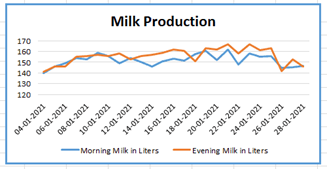Dairy farming demands a hardworking, determined, and patient farmer. The aspiring dairy farmer must know that there is no holiday. A dairy farmer must possess some substantial knowledge of bookkeeping and record keeping for effective business. It is important to have the right information to do it right. The key ‘drivers’ on dairy farming must be understood to develop an effective strategy.
Good recordkeeping is important to the financial health of the farm. However, good records alone do not ensure success, but success is unlikely without them. Records should tell how well the dairy farmer is managing the farm operations, and they indicate the strengths and weaknesses of the operation for effective decision making. Dairy farm records should be able:
- To assist in financial planning decisions
- To assist in livestock management decisions
- To assist in land management decisions
The guiding principle of dairy records management is to ensure that information is available as when and where it is needed, in an organized and efficient manner, and in a well-maintained environment. The purpose of keeping dairy farm records is to assist in financial planning decisions whereas the following questions should be asked:
- Is the farm making profit?
- Will the farm need to borrow money, how much and when?
- The monthly cash flow statement will show cash inflows against cash outflows on a timely basis.
Records must be maintained for specific purposes and the information contained in them must meet those purposes. Records will be identified and linked to the farm business process to which they are related, like to assist in livestock management decisions for:
- Individual animal records
- Production, health, heat cycle, date bred, calving, whom to cull, et cetera.
- Genetic improvement
- Breeding records – sire, dam, et cetera.
Land management leads to successful fodder production, which is one of the most important activities in dairying contributing to the profitability of the business. Fodder provides an economic nutrient source which is highly relished by the animals. Therefore, land management decisions enable the farmer to manage:
How many hectares are needed for pasture?
How much fodder to grow and how to keep it?
How many hectares should be available for other enterprises?
Where to put buildings, et cetera?
Type of record keeping
- Livestock records/identification records
- Production records
- Breeding and calving records
- Health records
- Animal feed records
- Daily farm records
- Financial records
Some examples of dairy farm records

These contain information about the number of animals on the farm. The records also include the name (if any), identification number, sex, date of birth/procurement date, breed, or any other identification mark an animal may have. Pictures or sketches of the animals, which indicate specific features, may also be kept as additional identification records.

This record is important to know the exact situation of the farm financially. Milk production records help to get a clear picture of the net input and output of the farm. It also helps in making important decisions like if the cost of feeding a particular animal is more than the yield, it might be time to sell the animal; or what is the best time to breed a cow; or which combination of cow and bull has most productive offspring. These records are very useful for making precise management decisions.
Methods of record keeping
When the types of records are understood, it is important to know the methods of record keeping:
Manual record keeping
Manual record keeping has been with us for ages. It may be successful at small farms, but as the size of the farm increases, it becomes cumbersome and more prone to errors. Some methods may be used to make the process a little less tedious, such as using a colour-coding system, card files, case folders, individual records, tags, et cetera. This gives a more systematic approach to the records and makes them easily accessible for day-to-day field use.
MS Excel or spreadsheet
With the advent of new technologies, record keeping has become simpler and error free. Computerized record keeping is more efficient than manual record keeping and recommended for a bigger farm.
Mobile apps
The fastest and the easiest way to save records nowadays is through mobile apps. They are easily accessible and just a tap away. They are user-friendly and can be used even by those who are not very computer conversant.
Benefits of dairy farm record keeping:
- It helps in maintaining the size of the farm by identifying the animals which are productive and non-productive, then culling the rest.
- It helps in the financial planning of the farm by determining the inflow and outflow of the products which determine the net profit of the farm and planning ahead.
- Record keeping is an excellent tool for keeping a check on the vaccination schedule, diseases, or any other unusual activity on the farm.
- Record keeping helps to manage a successful breeding system on the farm.
- It promotes effective feeding programmes.
- It also enables a farmer to determine the price of the products.
- Procurement and selling of animals become easy when you have access to the full records of each animal.
- Maintained records are also beneficial if the dairy farmer wants to get a loan from the bank to expand the business.
- Record keeping is also effective in the overall management of the farm.
For more information, contact Given Hamanungu at (+26) 0967-933-658 or (+26) 0975-403-834, send an e-mail to givenhams@gmail.com, or given.hamanungu@tigerfeeds.com.zm.









